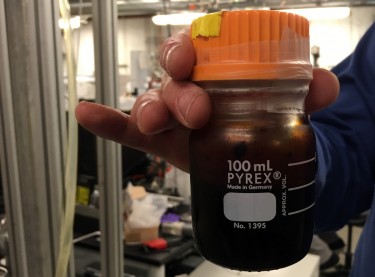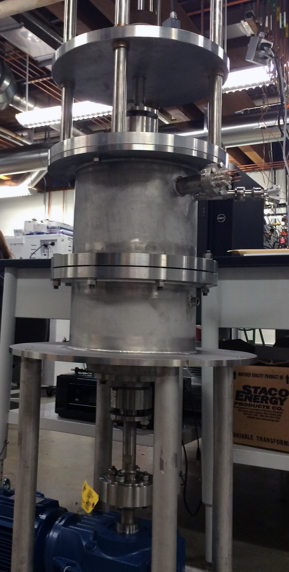May
4
An Improved Dead Wood To Biofuel Process
May 4, 2017 | 1 Comment
A University of Washington (UW) research team has made a new stride forward on a solution to remove beetle-killed trees from the forest and use them to make renewable transportation fuels or high-value chemicals. An important factor is they refined this technique to process larger pieces of wood than ever before, saving time and money in future commercial applications.

Lab sample of biofuel made from trees killed by the Mountain Pine Beetle. Image Credit: University of Washington. Click image for the largest view.
The dead wood source comes from the Mountain Pine Beetle who has destroyed more than 40 million acres of forest in the western United States. That amounts to an area the size of Washington state that is strewn with conifers – evergreens left for dead.
The beetles introduce a fungus that prevents critical nutrients and water from traveling within a tree. Beetles also lay their eggs under the bark and the feeding larvae help kill the trees, sometimes within several weeks of the initial attack. These standing dead trees can fall at any moment or add fuel to a wildfire, and scientists and land managers are left scrambling to deal with millions of the precarious dead giants. Harvesting the wood for lumber is not a marketing winner, because the infestation stains the wood and causes the tree to crack on the inside damaging its commercial value.
Senior author Fernando Resende, a UW assistant professor of bioresource science and engineering in the School of Environmental and Forest Sciences said, “We came up with a different way of converting wood into oil – that’s really the main accomplishment of this project. Not only do we want to reduce the costs, but we are hoping to increase the value of what we produce so we have a better chance of making it commercial.”
The process of heating wood and other natural materials at extreme temperatures to create oil – called “fast pyrolysis” – is being widely explored in research labs across the country. Each system varies, but generally the process involves heating small pieces of organic material in an oxygen-free chamber at about 500º Celsius, until the solid material becomes a vapor. As the vapor rises and moves into other chambers, it cools and becomes a dark brown liquid fuel. Scientists call this “bio oil,” and it is already used in some European countries for heating hospitals.
Researchers, including the UW team, currently are testing whether this bio oil can be upgraded by using catalysts. The upgrade intent is to convert the bio oil into transportation fuels that resemble gasoline and diesel.
Resende explained the beetle-killed trees are a good fit for making bio oil, in part because the entirety of a tree becomes extremely dry when it is killed by an infestation. That makes for a simpler fast-pyrolysis process, because it isn’t necessary to first dry the wood before heating it to extreme temperatures.
Resende explained, “If you can extract the wood and process it using fast pyrolysis, not only will you free up space and safety hazards in the forest, but you also have the organic liquid that could potentially be used for products.”
The system developed by Resende’s team can efficiently break down woodchip-sized pieces, though the team has successfully turned an entire log into bio oil. Other fast pyrolysis systems must use small wood pellets 1 to 2 millimeters in length, which often adds an time consuming and power demanding extra step of grinding larger pieces down to the appropriate size before converting them to bio oil.
In the UW method, woodchips are placed on a rotating surface and a hot stainless steel plate moves down from above, crushing the wood. The woodchips become hot from direct contact with the metallic surface, and the chemical transformation from solid to vapor begins.

The reactor in the UW lab. Image Credit: University of Washington. Click image for the largest view.
The researchers say this method could be used in mobile pyrolysis units so dead trees can be processed on site, saving on transportation costs associated with moving large pieces of wood out of the forest. The mobile units – cylinder-shaped reactors that sit on a small flatbed truck – are already being used for standard wood-to-oil processing, and the improvements by the UW team, they say, could make the process more efficient and cost effective.

Bare mountain sides from Mountain Pine Beetle damage in Canada’s Yoho National Park. Image Credit: Wikipedia. Click image for the largest view.
The mountain pine beetle is an ecological disaster. The damage in the U.S. alone as noted, approximates an area the size of Washington State. The bug is also working in Canada and the range is growing. If it were to attack the southern yellow pine forests the wood market would skyrocket. Taking down those dead trees and getting something worthwhile is an essential habitat protection and maintenance job.
That makes this team’s work extremely important and useful. Better some fuel, and the process looks to be as efficient as most any other as well as lower cost and quicker. Lets hope the forest management and industry get on with using this as soon as possible.
Comments
1 Comment so far


In fact, the wood waste is also useful. You can use the biomass carbonization plant to make charcoal from wood waste.